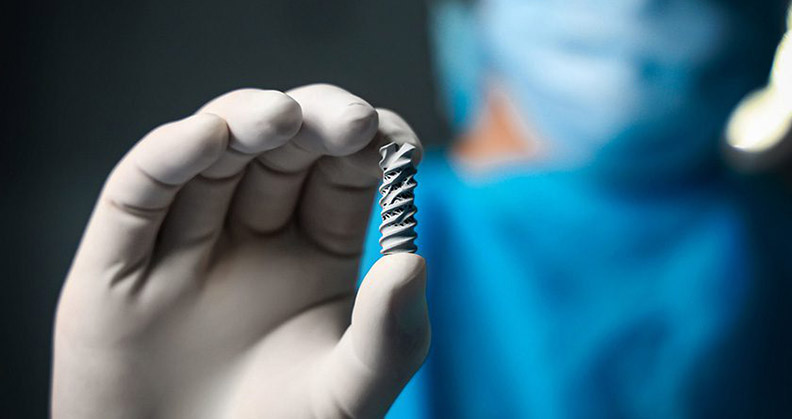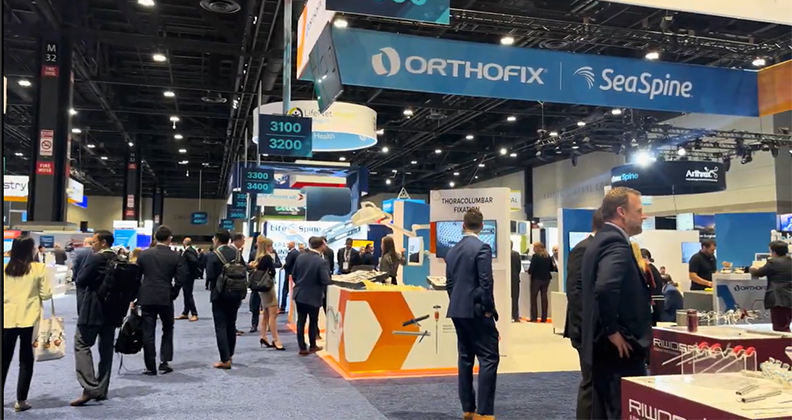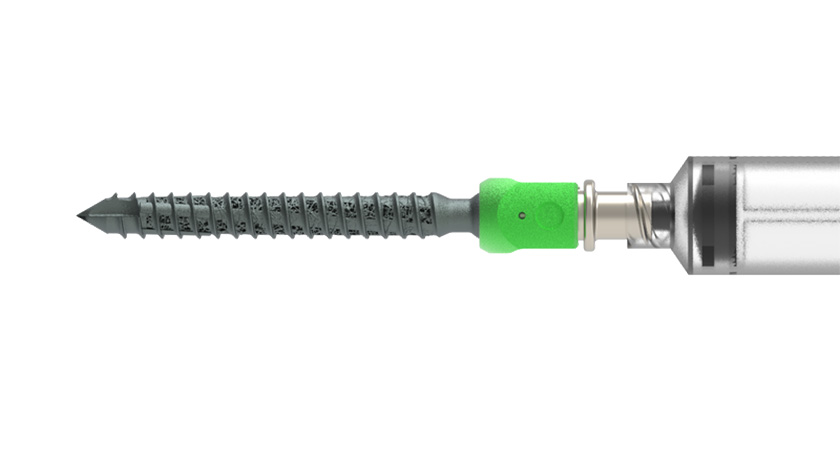
The orthopedic market remained steady and grew 5% in 2024 to $61.9 billion worldwide. While the market saw robust surgical demand in 2024, procedure volumes and seasonality further normalized. We expect further normalization in 2025. However, when the market does ultimately settle, it could do so at an overall growth rate near 4%, a meaningful bump compared to its pre-pandemic average of around 3.5% annual growth.
Exhibit 1: Worldwide Orthopedic Sales 2019-2028E
Multiple convergent tailwinds could elevate the orthopedic market’s growth rate modestly but meaningfully in the near term.
Beneficial Patient Demographics. The global population over the age of 65 is expanding rapidly and staying active for longer. Additionally, patients are entering the orthopedic care funnel younger than they had in the past.
Historically Low Uninsured Rates. According to the U.S. Department of Health and Human Services, the national uninsured rate reached an all-time low of 7.7% in 2023. As the potential patient population increases in the U.S., more people now have access to orthopedic care.
Improving Technology and Outcomes. Technologies like robotics, increased access to orthopedic ASCs and more flexibility due to remote work make patients more likely to undergo procedures. Improved patient confidence in successful outcomes could further elevate the largest orthopedic segments.
M&A Impacting the Market
Consolidation remains a significant force in orthopedics and has reshaped the industry’s landscape over the last few years. Below are three broad-based trends that have driven orthopedic M&A activity in recent years.
Technology Creates New Basis for Competition. Stryker changed the paradigm of joint replacement with its Mako robotic system. The technology race between Medtronic and Globus Medical did the same thing in spine. Medtronic CEO Geoffrey Martha believes the technological requirements for modern spine surgery will knock out small and large competitors alike. In recent years, digital assets saw much more M&A focus, while spine saw a commensurate drop.
Opportunities for International Expansion. Enovis greatly expanded its global footprint with the acquisitions of Mathys and LimaCorporate. Globus Medical did the same, to a lesser extent, with its NuVasive acquisition. Both companies have largely untapped potential for cross selling that could turn into a growth driver for 2025 and beyond.
Diversification into Faster Growing Segments. In April, Zimmer Biomet made a major move to contend in the foot and ankle space when it acquired Paragon 28. Zimmer Biomet’s combined S.E.T. segment revenue will outsize its hip franchise and grow faster than both its knee and hip franchises. The move is representative of the company’s strategic revenue diversification goals.
Segment Performance
Joint replacement and trauma overperformed relative to recent historical growth rates. Joint replacement’s years-long recovery from the pandemic carried some momentum in 2024 and could elevate demand into 2025. Meanwhile, a renewed focus on core trauma brought a fresh wave of innovation to the market, which helped offset choppiness in the foot and ankle space.
Exhibits 2 and 3 highlight segment revenue.
($Millions)
| Segment | FY24 | FY23 | $ Chg | % Chg |
|---|---|---|---|---|
| Joint Replacement | $22,617.3 | $21,474.0 | $1,143.3 | 5.3% |
| Knees | $10,637.3 | $10,097.6 | $539.8 | 5.3% |
| Hips | $8,745.8 | $8,369.0 | $376.8 | 4.5% |
| Extremities | $3,234.2 | $3,007.5 | $226.7 | 7.5% |
| Spine | $10,786.9 | $10,412.6 | $374.3 | 3.6% |
| Trauma | $9,070.1 | $8,532.4 | $537.7 | 6.3% |
| Sports Medicine | $7,162.8 | $6,775.6 | $387.2 | 5.7% |
| Orthobiologics | $5,681.8 | $5,500.3 | $181.5 | 3.3% |
| Enabling Technology | $1,422.0 | $1,307.0 | $115.1 | 8.8% |
| Other | $5,197.5 | $5,002.4 | $195.1 | 3.9% |
| Total | $61,938.5 | $59,004.3 | $2,934.2 | 5% |
Joint Replacement
- Robotics are well-established in knee and hip surgery, but Zimmer Biomet got to the market first in shoulders with its ROSA platform. Others, including Stryker and Smith+Nephew, are sure to follow and make shoulder robotics the next battleground.
- Procedure volumes were strong outside the U.S. and helped players like Johnson & Johnson MedTech improve their performance in 2024.
- The shift of procedures to the outpatient setting is ongoing, but remains limited by physical capacity and outdated operating rooms in older ASCs.
Spine
- It is becoming harder to be an implant-only company to compete. Even players with technology need a fully realized ecosystem to keep pace with the segment’s leaders. We expect more companies to be acquired or bow out of the market.
- The spine market remains disrupted due to the major M&A deals of recent years. We see this as a positive development for mid-tier, spine-only market players.
- Spine’s top players now include two privately held companies: VB Spine, which recently acquired Stryker’s spine implant business, and Highridge Medical, which was spun off from ZimVie. Both lack the robust digital ecosystem seemingly necessary for competition at the top. We’ll be watching closely to see how their presence impacts the market.
Trauma
- The trauma market benefits from patient demographic trends toward longer life, but increased incidence of diabetes and obesity. The latter is beneficial for the burgeoning foot and ankle subsegment.
- Treace Medical said its disruptive Lapiplasty procedure targets an estimated $5 billion opportunity in the U.S. While the overall foot and ankle market has evened out after a period of consolidation, segments like bunion surgery illustrate the market’s significant and sustained growth potential.
- The segment endured market softness and price cuts due to volume-based procurement (VBP) in China in recent years. Those factors mitigated in 2024 and reinforced trauma’s steady growth rate. At the same time, companies are refocusing on core trauma. Stryker’s Pangea plating system is its largest product launch ever in trauma, a business the company expects to yield big results over the long term.
Sports Medicine
- Top players found significant growth opportunities in markets outside the United States. According to Stryker, international sales of its flagship 1788 camera are driving growth across its entire portfolio.
- Companies across the revenue spectrum are positioning themselves to leverage regenerative products that could yield a market worth over $1 billion in a few years. Smaller players like Anika Therapeutics and incumbents such as Smith+Nephew remain focused on developing regenerative products for 2025 and beyond.
- Improved technology is driving sales within sports medicine and helping companies expand their reach across orthopedics. Arthrex, the leading sports medicine company, recently launched its endoscopic spine portfolio. Enhanced visualization could reduce the number of spinal fusions performed through large, open incisions and ultimately spread to more complex cases as surgeons gain proficiency.
Orthobiologics
- After a long period of company disruption, Bioventus performed exceptionally well in 2024. Its pain and joint segment averaged better than 20% growth in the last three quarters on the strength of DUROLANE and improved commercial execution. Bioventus’ surgical solutions business, including bone growth substitutes, is growing in the mid-teens.
- BONESUPPORT is one of the fastest-growing companies in orthopedics, with annual revenues surpassing $50 million and a four-year CAGR over 48%. FDA clearance of CERAMENT G in 2022 continues to drive tremendous growth for the company. Their story shows promising potential for other niche orthobiologic companies.
- Changing market dynamics have made orthobiologics assets valuable M&A targets. From 2017 to 2020, orthobiologics accounted for 9% of all orthopedic acquisitions. However, from 2021 to 2024, the segment jumped to 20% of transactions, making it the second busiest segment after spine.
Enabling Technology
- The top players are starting to embrace providing surgeons with optionality. This is part of a larger strategy shift at the biggest companies that aims to add breadth to enabling tech portfolios to entice adoption and utilization of technology that ultimately drives pull-through implant sales.
- Zimmer Biomet has an early lead in shoulder robotics, but competition will be hot on its heels. Additionally, Globus Medical expects its knee robot to be a contributor by 2026, while a host of companies outside the U.S. are making inroads in robotics.
- Smith+Nephew’s joint replacement business is losing money in China, but said it is waiting to see how the uptake of robotics plays out there before deciding whether to stay or leave the market.
Regional Performance
Markets largely normalized worldwide in 2024, with a few geographies remaining above average as surgeons worked through procedure backlogs from the pandemic.
While the largest orthopedic companies see significant global growth opportunities, China will remain a headwind in 2025 and beyond. We expect another round of VBP tenders on sports medicine products in 2025, and foreign companies have struggled to realize an upside in off-tender implant volumes, with most of it going to domestic Chinese companies.
The European Union’s Medical Device Regulation (MDR) remains a significant expense and regulatory hurdle for companies opting to stay in that market. While there are signs that MDR may undergo some changes and become more reasonable, regulatory consultants we heard from continue to caution clients about entering the EU market.
Smaller European and Asian companies have targeted North and South America for growth opportunities. These companies believe they can generate meaningful revenue in these regions, but face complexities when finding quality distributors and competing with orthopedics’ largest players.
Exhibits 4 and 5 depict regional orthopedic sales.
($Millions)
| Region | FY24 | FY23 | $ Chg | % Chg |
|---|---|---|---|---|
| US | $41,604.9 | $39,581.1 | $2,023.8 | 5.1% |
| OUS | $20,333.6 | $19,423.2 | $910.4 | 4.7% |
| EMEA | $11,426.3 | $10,744.2 | $682.1 | 6.3% |
| APAC | $6,830.5 | $6,698.1 | $132.4 | 2% |
| ROW | $2,076.8 | $1,980.9 | $95.9 | 4.8% |
| Total | $61,938.5 | $59,004.3 | $2,934.2 | 5% |
Company Sales Performance
The orthopedic market has more than 1,000 active companies. Our estimates show the eight largest companies account for 68% of all global orthopedic sales, while the 50 largest companies account for 85% of total sales.
Consolidation remains a significant force in the market. While acquisitions have become more infrequent in the post-pandemic era, some of them are massive strategic deals that change the market’s landscape.
A breakdown of companies by revenue tiers is shown in Exhibits 6-8
($Millions)
| Tier | FY24 | FY23 | $ Chg | % Chg |
|---|---|---|---|---|
| 8 Companies Over $1 Billion | $41,788.6 | $39,751.2 | $2,037.4 | 5.1% |
| 9 Companies $400 to $999 Million | $5,170.8 | $4,801.2 | $369.6 | 7.7% |
| 10 Companies $200 to $399 Million | $2,667.6 | $2,464.8 | $202.8 | 8.2% |
| 18 Companies $100 to $199 | $2,681.6 | $2,558.2 | $123.4 | 4.8% |
| All Others | $9,630.0 | $9,429.0 | $201.0 | 2.1% |
| Total | $61,938.5 | $59,004.3 | $2,934.2 | 5% |
($Millions)
| Company | FY24 | FY23 | $ Chg | % Chg |
|---|---|---|---|---|
| Stryker | $10,891.7 | $10,020.5 | $871.3 | 8.7% |
| J&J MedTech | $9,158.0 | $8,941.6 | $216.4 | 2.4% |
| Zimmer Biomet | $7,678.4 | $7,394.3 | $284.1 | 3.8% |
| Smith+Nephew | $3,918.8 | $3,747.6 | $171.2 | 4.6% |
| Medtronic | $3,430.7 | $3,276.2 | $154.5 | 4.7% |
| Arthrex | $3,125.8 | $2,990.7 | $135.1 | 4.5% |
| Globus Medical | $2,519.4 | $2,395.8 | $123.5 | 5.2% |
| Enovis | $1,065.7 | $984.4 | $81.3 | 8.3% |
| Subtotal | $41,788.6 | $39,751.2 | $2,037.4 | 5.1% |
| Total | $61,938.5 | $59,004.3 | $2,934.2 | 5% |
Companies Over $1 Billion
The eight largest companies combined for a total of $42 billion in sales in 2024.
The top four companies — Stryker, Johnson & Johnson MedTech, Zimmer Biomet and Smith+Nephew — dominate the joint replacement market. Meanwhile, Medtronic saw its closest competitor, Globus Medical, leap forward with its NuVasive merger. Enovis joined this tier in 2024 after it acquired LimaCorporate.
Here are some of the developments we’re watching for these companies.
Joint Replacement Upside. Joint replacement ran hot the last two years, but it is worth remembering that most players in this space didn’t attain their 2019 sales levels again until sometime in 2023. New technologies and strong patient demand could keep growth rates elevated in 2025.
Changing Competitive Dynamics. The winning formula in spine is scale plus technology. Few companies have the resources required to compete with the largest spine players. As technology becomes more ingrained in orthopedic surgeries, the disparity will grow and potentially force smaller players out of the market.
Self-Inflicted Wounds. Smith+Nephew remains focused on its 12-point improvement plan amid calls from investors for the company to divest its recon franchises, while Zimmer Biomet contended with ERP integration issues in late 2024.
Select Developments from Mid-Sized and Smaller Companies
Orthofix Finds Synergies. The company had a tumultuous few years, predating even the pandemic. Following a merger with SeaSpine and a nearly wholesale leadership change, Orthofix turned in a strong 2024 and looks poised to build on that success in 2025. Improving synergy among products and a largely untapped U.S. orthopedics opportunity will boost company growth.
Medacta’s Steady Execution. The company once again outperformed the markets where it competes, growing in the mid-teens for 2024. Knee and shoulder replacement sales were especially strong for Medacta, and the company is expanding its presence in the sports medicine segment.
ATEC Poised for Significant Growth. Over the last few years, the company racked up impressive CAGR numbers: 40% total revenue, 19% surgeon adoption, 25% procedure volume and 10% revenue per procedure. ATEC is bullish on its prospects, given the ongoing disruption of the spine market.
OrthoPediatrics Racing to Market Dominance. While the market’s top players pay less attention to pediatric orthopedics, one company is quickly amassing share. OrthoPediatrics has quietly developed into one of the more acquisitive companies in the industry and has positioned itself to control up to 50% of the pediatric trauma and deformity market in the next few years.
The orthopedic market will have no shortage of compelling developments to monitor moving forward. It will be interesting to see how companies respond to dynamic competitive forces with strategic innovation aimed at improving revenue share and enhancing patient outcomes.




